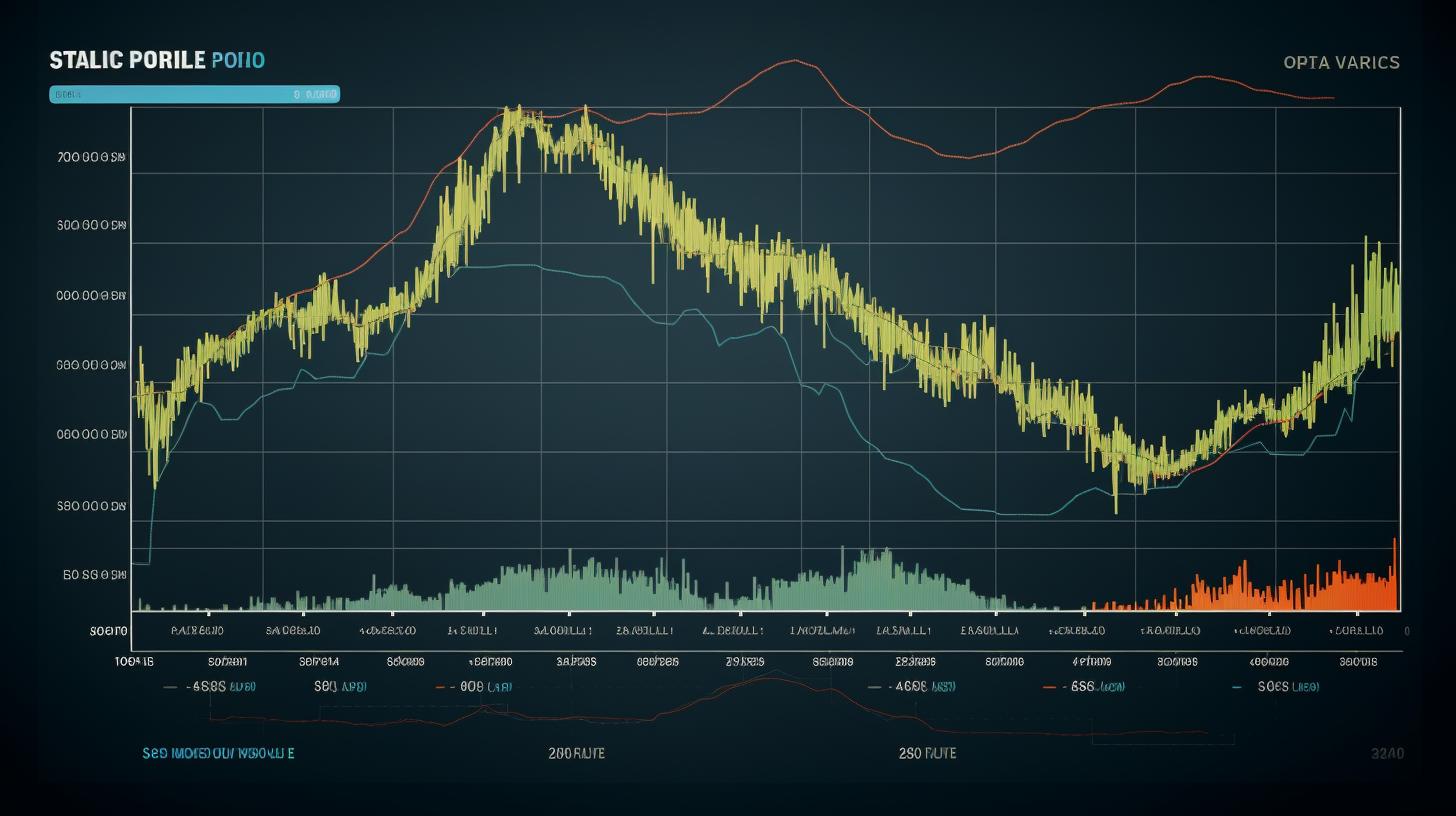Nvidia’s strategic shift to U.S.-based production and technology partnerships underscores its pivotal role in national security and technological sovereignty. While export restrictions present near-term challenges, the company’s investments in telecommunications and quantum computing position it well for long-term growth. !-- wp:paragraph -->
Contents
FinOracleAI — Market ViewFinOracleAI — Market ViewAdvancing Quantum Computing Through NVQLink and SupercomputersFinOracleAI — Market ViewAdvancing Quantum Computing Through NVQLink and SupercomputersFinOracleAI — Market ViewAdvancing Quantum Computing Through NVQLink and SupercomputersFinOracleAI — Market ViewExport Restrictions and Challenges in China MarketAdvancing Quantum Computing Through NVQLink and SupercomputersFinOracleAI — Market ViewExport Restrictions and Challenges in China MarketAdvancing Quantum Computing Through NVQLink and SupercomputersFinOracleAI — Market ViewExport Restrictions and Challenges in China MarketAdvancing Quantum Computing Through NVQLink and SupercomputersFinOracleAI — Market ViewNvidia Partners with Nokia to Advance American 5G and 6G NetworksExport Restrictions and Challenges in China MarketAdvancing Quantum Computing Through NVQLink and SupercomputersFinOracleAI — Market ViewNvidia Partners with Nokia to Advance American 5G and 6G NetworksExport Restrictions and Challenges in China MarketAdvancing Quantum Computing Through NVQLink and SupercomputersFinOracleAI — Market ViewNvidia Partners with Nokia to Advance American 5G and 6G NetworksExport Restrictions and Challenges in China MarketAdvancing Quantum Computing Through NVQLink and SupercomputersFinOracleAI — Market ViewStrategic Focus on U.S. Technology Leadership and Policy EngagementNvidia Partners with Nokia to Advance American 5G and 6G NetworksExport Restrictions and Challenges in China MarketAdvancing Quantum Computing Through NVQLink and SupercomputersFinOracleAI — Market ViewStrategic Focus on U.S. Technology Leadership and Policy EngagementNvidia Partners with Nokia to Advance American 5G and 6G NetworksExport Restrictions and Challenges in China MarketAdvancing Quantum Computing Through NVQLink and SupercomputersFinOracleAI — Market ViewStrategic Focus on U.S. Technology Leadership and Policy EngagementNvidia Partners with Nokia to Advance American 5G and 6G NetworksExport Restrictions and Challenges in China MarketAdvancing Quantum Computing Through NVQLink and SupercomputersFinOracleAI — Market ViewNvidia Initiates Full Production of Blackwell AI Chips in ArizonaStrategic Focus on U.S. Technology Leadership and Policy EngagementNvidia Partners with Nokia to Advance American 5G and 6G NetworksExport Restrictions and Challenges in China MarketAdvancing Quantum Computing Through NVQLink and SupercomputersFinOracleAI — Market View
- Opportunities: Expansion of domestic semiconductor manufacturing enhances supply chain resilience and national security.
- Partnership with Nokia opens a $3 trillion telecom market with U.S.-based technology leadership.
- Quantum computing initiatives strengthen Nvidia’s position in emerging high-performance computing domains.
- Strong demand for AI GPUs supports robust revenue projections through 2026.
- Risks: Ongoing U.S.-China export restrictions limit access to a critical market, impacting near-term revenues.
- Geopolitical tensions could further complicate supply chains and regulatory environments.
- Competition from foreign semiconductor manufacturers remains intense.
FinOracleAI — Market View
Nvidia’s strategic shift to U.S.-based production and technology partnerships underscores its pivotal role in national security and technological sovereignty. While export restrictions present near-term challenges, the company’s investments in telecommunications and quantum computing position it well for long-term growth. !-- wp:paragraph -->- Opportunities: Expansion of domestic semiconductor manufacturing enhances supply chain resilience and national security.
- Partnership with Nokia opens a $3 trillion telecom market with U.S.-based technology leadership.
- Quantum computing initiatives strengthen Nvidia’s position in emerging high-performance computing domains.
- Strong demand for AI GPUs supports robust revenue projections through 2026.
- Risks: Ongoing U.S.-China export restrictions limit access to a critical market, impacting near-term revenues.
- Geopolitical tensions could further complicate supply chains and regulatory environments.
- Competition from foreign semiconductor manufacturers remains intense.
“Researchers will be able to do more than just error correction,” Huang said. “They will also be able to orchestrate quantum devices and AI supercomputers to run quantum GPU applications.” Seventeen quantum computing startups have committed to producing hardware compatible with NVQLink. Nvidia also announced a partnership with the U.S. Department of Energy to develop seven new supercomputers.
!-- wp:paragraph -->FinOracleAI — Market View
Nvidia’s strategic shift to U.S.-based production and technology partnerships underscores its pivotal role in national security and technological sovereignty. While export restrictions present near-term challenges, the company’s investments in telecommunications and quantum computing position it well for long-term growth. !-- wp:paragraph -->- Opportunities: Expansion of domestic semiconductor manufacturing enhances supply chain resilience and national security.
- Partnership with Nokia opens a $3 trillion telecom market with U.S.-based technology leadership.
- Quantum computing initiatives strengthen Nvidia’s position in emerging high-performance computing domains.
- Strong demand for AI GPUs supports robust revenue projections through 2026.
- Risks: Ongoing U.S.-China export restrictions limit access to a critical market, impacting near-term revenues.
- Geopolitical tensions could further complicate supply chains and regulatory environments.
- Competition from foreign semiconductor manufacturers remains intense.
Advancing Quantum Computing Through NVQLink and Supercomputers
Nvidia unveiled NVQLink, a novel interface to connect quantum chips with its GPUs, enhancing quantum computing capabilities. This initiative aligns with U.S. concerns over maintaining a technological edge in quantum computing to safeguard military communications. !-- wp:paragraph -->“Researchers will be able to do more than just error correction,” Huang said. “They will also be able to orchestrate quantum devices and AI supercomputers to run quantum GPU applications.” Seventeen quantum computing startups have committed to producing hardware compatible with NVQLink. Nvidia also announced a partnership with the U.S. Department of Energy to develop seven new supercomputers.
!-- wp:paragraph -->FinOracleAI — Market View
Nvidia’s strategic shift to U.S.-based production and technology partnerships underscores its pivotal role in national security and technological sovereignty. While export restrictions present near-term challenges, the company’s investments in telecommunications and quantum computing position it well for long-term growth. !-- wp:paragraph -->- Opportunities: Expansion of domestic semiconductor manufacturing enhances supply chain resilience and national security.
- Partnership with Nokia opens a $3 trillion telecom market with U.S.-based technology leadership.
- Quantum computing initiatives strengthen Nvidia’s position in emerging high-performance computing domains.
- Strong demand for AI GPUs supports robust revenue projections through 2026.
- Risks: Ongoing U.S.-China export restrictions limit access to a critical market, impacting near-term revenues.
- Geopolitical tensions could further complicate supply chains and regulatory environments.
- Competition from foreign semiconductor manufacturers remains intense.
Advancing Quantum Computing Through NVQLink and Supercomputers
Nvidia unveiled NVQLink, a novel interface to connect quantum chips with its GPUs, enhancing quantum computing capabilities. This initiative aligns with U.S. concerns over maintaining a technological edge in quantum computing to safeguard military communications. !-- wp:paragraph -->“Researchers will be able to do more than just error correction,” Huang said. “They will also be able to orchestrate quantum devices and AI supercomputers to run quantum GPU applications.” Seventeen quantum computing startups have committed to producing hardware compatible with NVQLink. Nvidia also announced a partnership with the U.S. Department of Energy to develop seven new supercomputers.
!-- wp:paragraph -->FinOracleAI — Market View
Nvidia’s strategic shift to U.S.-based production and technology partnerships underscores its pivotal role in national security and technological sovereignty. While export restrictions present near-term challenges, the company’s investments in telecommunications and quantum computing position it well for long-term growth. !-- wp:paragraph -->- Opportunities: Expansion of domestic semiconductor manufacturing enhances supply chain resilience and national security.
- Partnership with Nokia opens a $3 trillion telecom market with U.S.-based technology leadership.
- Quantum computing initiatives strengthen Nvidia’s position in emerging high-performance computing domains.
- Strong demand for AI GPUs supports robust revenue projections through 2026.
- Risks: Ongoing U.S.-China export restrictions limit access to a critical market, impacting near-term revenues.
- Geopolitical tensions could further complicate supply chains and regulatory environments.
- Competition from foreign semiconductor manufacturers remains intense.
Advancing Quantum Computing Through NVQLink and Supercomputers
Nvidia unveiled NVQLink, a novel interface to connect quantum chips with its GPUs, enhancing quantum computing capabilities. This initiative aligns with U.S. concerns over maintaining a technological edge in quantum computing to safeguard military communications. !-- wp:paragraph -->“Researchers will be able to do more than just error correction,” Huang said. “They will also be able to orchestrate quantum devices and AI supercomputers to run quantum GPU applications.” Seventeen quantum computing startups have committed to producing hardware compatible with NVQLink. Nvidia also announced a partnership with the U.S. Department of Energy to develop seven new supercomputers.
!-- wp:paragraph -->FinOracleAI — Market View
Nvidia’s strategic shift to U.S.-based production and technology partnerships underscores its pivotal role in national security and technological sovereignty. While export restrictions present near-term challenges, the company’s investments in telecommunications and quantum computing position it well for long-term growth. !-- wp:paragraph -->- Opportunities: Expansion of domestic semiconductor manufacturing enhances supply chain resilience and national security.
- Partnership with Nokia opens a $3 trillion telecom market with U.S.-based technology leadership.
- Quantum computing initiatives strengthen Nvidia’s position in emerging high-performance computing domains.
- Strong demand for AI GPUs supports robust revenue projections through 2026.
- Risks: Ongoing U.S.-China export restrictions limit access to a critical market, impacting near-term revenues.
- Geopolitical tensions could further complicate supply chains and regulatory environments.
- Competition from foreign semiconductor manufacturers remains intense.
Export Restrictions and Challenges in China Market
Nvidia faces significant headwinds due to U.S. export controls, which have curtailed sales in China. The company disclosed that export restrictions on the H20 chip, designed to comply with U.S. rules, have cost it approximately $10.5 billion in potential revenue over two quarters. !-- wp:paragraph --> Despite receiving conditional approvals to ship the H20 chip to China, Nvidia’s market share there remains nonexistent. Huang acknowledged Nvidia is currently “100% out of China,” reflecting ongoing geopolitical and regulatory hurdles. !-- wp:paragraph --> Huang has lobbied U.S. officials, including a July meeting with Trump, to relax restrictions, arguing that it benefits American interests for Chinese AI developers to use Nvidia technology rather than develop indigenous alternatives. !-- wp:paragraph -->Advancing Quantum Computing Through NVQLink and Supercomputers
Nvidia unveiled NVQLink, a novel interface to connect quantum chips with its GPUs, enhancing quantum computing capabilities. This initiative aligns with U.S. concerns over maintaining a technological edge in quantum computing to safeguard military communications. !-- wp:paragraph -->“Researchers will be able to do more than just error correction,” Huang said. “They will also be able to orchestrate quantum devices and AI supercomputers to run quantum GPU applications.” Seventeen quantum computing startups have committed to producing hardware compatible with NVQLink. Nvidia also announced a partnership with the U.S. Department of Energy to develop seven new supercomputers.
!-- wp:paragraph -->FinOracleAI — Market View
Nvidia’s strategic shift to U.S.-based production and technology partnerships underscores its pivotal role in national security and technological sovereignty. While export restrictions present near-term challenges, the company’s investments in telecommunications and quantum computing position it well for long-term growth. !-- wp:paragraph -->- Opportunities: Expansion of domestic semiconductor manufacturing enhances supply chain resilience and national security.
- Partnership with Nokia opens a $3 trillion telecom market with U.S.-based technology leadership.
- Quantum computing initiatives strengthen Nvidia’s position in emerging high-performance computing domains.
- Strong demand for AI GPUs supports robust revenue projections through 2026.
- Risks: Ongoing U.S.-China export restrictions limit access to a critical market, impacting near-term revenues.
- Geopolitical tensions could further complicate supply chains and regulatory environments.
- Competition from foreign semiconductor manufacturers remains intense.
Export Restrictions and Challenges in China Market
Nvidia faces significant headwinds due to U.S. export controls, which have curtailed sales in China. The company disclosed that export restrictions on the H20 chip, designed to comply with U.S. rules, have cost it approximately $10.5 billion in potential revenue over two quarters. !-- wp:paragraph --> Despite receiving conditional approvals to ship the H20 chip to China, Nvidia’s market share there remains nonexistent. Huang acknowledged Nvidia is currently “100% out of China,” reflecting ongoing geopolitical and regulatory hurdles. !-- wp:paragraph --> Huang has lobbied U.S. officials, including a July meeting with Trump, to relax restrictions, arguing that it benefits American interests for Chinese AI developers to use Nvidia technology rather than develop indigenous alternatives. !-- wp:paragraph -->Advancing Quantum Computing Through NVQLink and Supercomputers
Nvidia unveiled NVQLink, a novel interface to connect quantum chips with its GPUs, enhancing quantum computing capabilities. This initiative aligns with U.S. concerns over maintaining a technological edge in quantum computing to safeguard military communications. !-- wp:paragraph -->“Researchers will be able to do more than just error correction,” Huang said. “They will also be able to orchestrate quantum devices and AI supercomputers to run quantum GPU applications.” Seventeen quantum computing startups have committed to producing hardware compatible with NVQLink. Nvidia also announced a partnership with the U.S. Department of Energy to develop seven new supercomputers.
!-- wp:paragraph -->FinOracleAI — Market View
Nvidia’s strategic shift to U.S.-based production and technology partnerships underscores its pivotal role in national security and technological sovereignty. While export restrictions present near-term challenges, the company’s investments in telecommunications and quantum computing position it well for long-term growth. !-- wp:paragraph -->- Opportunities: Expansion of domestic semiconductor manufacturing enhances supply chain resilience and national security.
- Partnership with Nokia opens a $3 trillion telecom market with U.S.-based technology leadership.
- Quantum computing initiatives strengthen Nvidia’s position in emerging high-performance computing domains.
- Strong demand for AI GPUs supports robust revenue projections through 2026.
- Risks: Ongoing U.S.-China export restrictions limit access to a critical market, impacting near-term revenues.
- Geopolitical tensions could further complicate supply chains and regulatory environments.
- Competition from foreign semiconductor manufacturers remains intense.
“Thank you for helping the United States bring telecommunication technology back to America,” Huang said, addressing Nokia CEO Justin Hotard. This collaboration aims to counterbalance the global influence of Chinese telecom giant Huawei, which has been effectively banned in the U.S. since 2018. Nokia and Ericsson remain primary vendors for U.S. cellular networks.
!-- wp:paragraph --> Nokia will integrate Nvidia’s ARC platform, a combination of the Grace GPU, Blackwell GPU, and networking components, into its base stations. Huang highlighted AI’s potential over 6G networks to enable advanced robotics and improve weather forecasting.
!-- wp:paragraph -->Export Restrictions and Challenges in China Market
Nvidia faces significant headwinds due to U.S. export controls, which have curtailed sales in China. The company disclosed that export restrictions on the H20 chip, designed to comply with U.S. rules, have cost it approximately $10.5 billion in potential revenue over two quarters. !-- wp:paragraph --> Despite receiving conditional approvals to ship the H20 chip to China, Nvidia’s market share there remains nonexistent. Huang acknowledged Nvidia is currently “100% out of China,” reflecting ongoing geopolitical and regulatory hurdles. !-- wp:paragraph --> Huang has lobbied U.S. officials, including a July meeting with Trump, to relax restrictions, arguing that it benefits American interests for Chinese AI developers to use Nvidia technology rather than develop indigenous alternatives. !-- wp:paragraph -->Advancing Quantum Computing Through NVQLink and Supercomputers
Nvidia unveiled NVQLink, a novel interface to connect quantum chips with its GPUs, enhancing quantum computing capabilities. This initiative aligns with U.S. concerns over maintaining a technological edge in quantum computing to safeguard military communications. !-- wp:paragraph -->“Researchers will be able to do more than just error correction,” Huang said. “They will also be able to orchestrate quantum devices and AI supercomputers to run quantum GPU applications.” Seventeen quantum computing startups have committed to producing hardware compatible with NVQLink. Nvidia also announced a partnership with the U.S. Department of Energy to develop seven new supercomputers.
!-- wp:paragraph -->FinOracleAI — Market View
Nvidia’s strategic shift to U.S.-based production and technology partnerships underscores its pivotal role in national security and technological sovereignty. While export restrictions present near-term challenges, the company’s investments in telecommunications and quantum computing position it well for long-term growth. !-- wp:paragraph -->- Opportunities: Expansion of domestic semiconductor manufacturing enhances supply chain resilience and national security.
- Partnership with Nokia opens a $3 trillion telecom market with U.S.-based technology leadership.
- Quantum computing initiatives strengthen Nvidia’s position in emerging high-performance computing domains.
- Strong demand for AI GPUs supports robust revenue projections through 2026.
- Risks: Ongoing U.S.-China export restrictions limit access to a critical market, impacting near-term revenues.
- Geopolitical tensions could further complicate supply chains and regulatory environments.
- Competition from foreign semiconductor manufacturers remains intense.
Nvidia Partners with Nokia to Advance American 5G and 6G Networks
Nvidia announced a strategic partnership with Finland-based Nokia, valued at $1 billion through Nvidia’s equity stake, to develop telecommunications equipment for 5G and future 6G networks. Huang stressed the importance of basing wireless infrastructure on U.S. technology to reduce reliance on foreign suppliers. !-- wp:paragraph -->“Thank you for helping the United States bring telecommunication technology back to America,” Huang said, addressing Nokia CEO Justin Hotard. This collaboration aims to counterbalance the global influence of Chinese telecom giant Huawei, which has been effectively banned in the U.S. since 2018. Nokia and Ericsson remain primary vendors for U.S. cellular networks.
!-- wp:paragraph --> Nokia will integrate Nvidia’s ARC platform, a combination of the Grace GPU, Blackwell GPU, and networking components, into its base stations. Huang highlighted AI’s potential over 6G networks to enable advanced robotics and improve weather forecasting.
!-- wp:paragraph -->Export Restrictions and Challenges in China Market
Nvidia faces significant headwinds due to U.S. export controls, which have curtailed sales in China. The company disclosed that export restrictions on the H20 chip, designed to comply with U.S. rules, have cost it approximately $10.5 billion in potential revenue over two quarters. !-- wp:paragraph --> Despite receiving conditional approvals to ship the H20 chip to China, Nvidia’s market share there remains nonexistent. Huang acknowledged Nvidia is currently “100% out of China,” reflecting ongoing geopolitical and regulatory hurdles. !-- wp:paragraph --> Huang has lobbied U.S. officials, including a July meeting with Trump, to relax restrictions, arguing that it benefits American interests for Chinese AI developers to use Nvidia technology rather than develop indigenous alternatives. !-- wp:paragraph -->Advancing Quantum Computing Through NVQLink and Supercomputers
Nvidia unveiled NVQLink, a novel interface to connect quantum chips with its GPUs, enhancing quantum computing capabilities. This initiative aligns with U.S. concerns over maintaining a technological edge in quantum computing to safeguard military communications. !-- wp:paragraph -->“Researchers will be able to do more than just error correction,” Huang said. “They will also be able to orchestrate quantum devices and AI supercomputers to run quantum GPU applications.” Seventeen quantum computing startups have committed to producing hardware compatible with NVQLink. Nvidia also announced a partnership with the U.S. Department of Energy to develop seven new supercomputers.
!-- wp:paragraph -->FinOracleAI — Market View
Nvidia’s strategic shift to U.S.-based production and technology partnerships underscores its pivotal role in national security and technological sovereignty. While export restrictions present near-term challenges, the company’s investments in telecommunications and quantum computing position it well for long-term growth. !-- wp:paragraph -->- Opportunities: Expansion of domestic semiconductor manufacturing enhances supply chain resilience and national security.
- Partnership with Nokia opens a $3 trillion telecom market with U.S.-based technology leadership.
- Quantum computing initiatives strengthen Nvidia’s position in emerging high-performance computing domains.
- Strong demand for AI GPUs supports robust revenue projections through 2026.
- Risks: Ongoing U.S.-China export restrictions limit access to a critical market, impacting near-term revenues.
- Geopolitical tensions could further complicate supply chains and regulatory environments.
- Competition from foreign semiconductor manufacturers remains intense.
Nvidia Partners with Nokia to Advance American 5G and 6G Networks
Nvidia announced a strategic partnership with Finland-based Nokia, valued at $1 billion through Nvidia’s equity stake, to develop telecommunications equipment for 5G and future 6G networks. Huang stressed the importance of basing wireless infrastructure on U.S. technology to reduce reliance on foreign suppliers. !-- wp:paragraph -->“Thank you for helping the United States bring telecommunication technology back to America,” Huang said, addressing Nokia CEO Justin Hotard. This collaboration aims to counterbalance the global influence of Chinese telecom giant Huawei, which has been effectively banned in the U.S. since 2018. Nokia and Ericsson remain primary vendors for U.S. cellular networks.
!-- wp:paragraph --> Nokia will integrate Nvidia’s ARC platform, a combination of the Grace GPU, Blackwell GPU, and networking components, into its base stations. Huang highlighted AI’s potential over 6G networks to enable advanced robotics and improve weather forecasting.
!-- wp:paragraph -->Export Restrictions and Challenges in China Market
Nvidia faces significant headwinds due to U.S. export controls, which have curtailed sales in China. The company disclosed that export restrictions on the H20 chip, designed to comply with U.S. rules, have cost it approximately $10.5 billion in potential revenue over two quarters. !-- wp:paragraph --> Despite receiving conditional approvals to ship the H20 chip to China, Nvidia’s market share there remains nonexistent. Huang acknowledged Nvidia is currently “100% out of China,” reflecting ongoing geopolitical and regulatory hurdles. !-- wp:paragraph --> Huang has lobbied U.S. officials, including a July meeting with Trump, to relax restrictions, arguing that it benefits American interests for Chinese AI developers to use Nvidia technology rather than develop indigenous alternatives. !-- wp:paragraph -->Advancing Quantum Computing Through NVQLink and Supercomputers
Nvidia unveiled NVQLink, a novel interface to connect quantum chips with its GPUs, enhancing quantum computing capabilities. This initiative aligns with U.S. concerns over maintaining a technological edge in quantum computing to safeguard military communications. !-- wp:paragraph -->“Researchers will be able to do more than just error correction,” Huang said. “They will also be able to orchestrate quantum devices and AI supercomputers to run quantum GPU applications.” Seventeen quantum computing startups have committed to producing hardware compatible with NVQLink. Nvidia also announced a partnership with the U.S. Department of Energy to develop seven new supercomputers.
!-- wp:paragraph -->FinOracleAI — Market View
Nvidia’s strategic shift to U.S.-based production and technology partnerships underscores its pivotal role in national security and technological sovereignty. While export restrictions present near-term challenges, the company’s investments in telecommunications and quantum computing position it well for long-term growth. !-- wp:paragraph -->- Opportunities: Expansion of domestic semiconductor manufacturing enhances supply chain resilience and national security.
- Partnership with Nokia opens a $3 trillion telecom market with U.S.-based technology leadership.
- Quantum computing initiatives strengthen Nvidia’s position in emerging high-performance computing domains.
- Strong demand for AI GPUs supports robust revenue projections through 2026.
- Risks: Ongoing U.S.-China export restrictions limit access to a critical market, impacting near-term revenues.
- Geopolitical tensions could further complicate supply chains and regulatory environments.
- Competition from foreign semiconductor manufacturers remains intense.
Nvidia Partners with Nokia to Advance American 5G and 6G Networks
Nvidia announced a strategic partnership with Finland-based Nokia, valued at $1 billion through Nvidia’s equity stake, to develop telecommunications equipment for 5G and future 6G networks. Huang stressed the importance of basing wireless infrastructure on U.S. technology to reduce reliance on foreign suppliers. !-- wp:paragraph -->“Thank you for helping the United States bring telecommunication technology back to America,” Huang said, addressing Nokia CEO Justin Hotard. This collaboration aims to counterbalance the global influence of Chinese telecom giant Huawei, which has been effectively banned in the U.S. since 2018. Nokia and Ericsson remain primary vendors for U.S. cellular networks.
!-- wp:paragraph --> Nokia will integrate Nvidia’s ARC platform, a combination of the Grace GPU, Blackwell GPU, and networking components, into its base stations. Huang highlighted AI’s potential over 6G networks to enable advanced robotics and improve weather forecasting.
!-- wp:paragraph -->Export Restrictions and Challenges in China Market
Nvidia faces significant headwinds due to U.S. export controls, which have curtailed sales in China. The company disclosed that export restrictions on the H20 chip, designed to comply with U.S. rules, have cost it approximately $10.5 billion in potential revenue over two quarters. !-- wp:paragraph --> Despite receiving conditional approvals to ship the H20 chip to China, Nvidia’s market share there remains nonexistent. Huang acknowledged Nvidia is currently “100% out of China,” reflecting ongoing geopolitical and regulatory hurdles. !-- wp:paragraph --> Huang has lobbied U.S. officials, including a July meeting with Trump, to relax restrictions, arguing that it benefits American interests for Chinese AI developers to use Nvidia technology rather than develop indigenous alternatives. !-- wp:paragraph -->Advancing Quantum Computing Through NVQLink and Supercomputers
Nvidia unveiled NVQLink, a novel interface to connect quantum chips with its GPUs, enhancing quantum computing capabilities. This initiative aligns with U.S. concerns over maintaining a technological edge in quantum computing to safeguard military communications. !-- wp:paragraph -->“Researchers will be able to do more than just error correction,” Huang said. “They will also be able to orchestrate quantum devices and AI supercomputers to run quantum GPU applications.” Seventeen quantum computing startups have committed to producing hardware compatible with NVQLink. Nvidia also announced a partnership with the U.S. Department of Energy to develop seven new supercomputers.
!-- wp:paragraph -->FinOracleAI — Market View
Nvidia’s strategic shift to U.S.-based production and technology partnerships underscores its pivotal role in national security and technological sovereignty. While export restrictions present near-term challenges, the company’s investments in telecommunications and quantum computing position it well for long-term growth. !-- wp:paragraph -->- Opportunities: Expansion of domestic semiconductor manufacturing enhances supply chain resilience and national security.
- Partnership with Nokia opens a $3 trillion telecom market with U.S.-based technology leadership.
- Quantum computing initiatives strengthen Nvidia’s position in emerging high-performance computing domains.
- Strong demand for AI GPUs supports robust revenue projections through 2026.
- Risks: Ongoing U.S.-China export restrictions limit access to a critical market, impacting near-term revenues.
- Geopolitical tensions could further complicate supply chains and regulatory environments.
- Competition from foreign semiconductor manufacturers remains intense.
Strategic Focus on U.S. Technology Leadership and Policy Engagement
The GTC event’s location in Washington underscores Nvidia’s intent to engage policymakers directly. Huang emphasized Nvidia’s critical role in the U.S. technology stack and cautioned that restricting Nvidia’s chip exports could undermine American interests. !-- wp:paragraph --> While the conference was arranged to accommodate former President Trump’s attendance, he was abroad in Asia at the time. However, Trump confirmed plans to meet with Huang shortly thereafter. !-- wp:paragraph --> Demand for Nvidia’s GPUs remains robust, with 6 million Blackwell units shipped over the past year. Huang projected combined sales of $500 billion across the Blackwell generation and next year’s Rubin chips. !-- wp:paragraph -->Nvidia Partners with Nokia to Advance American 5G and 6G Networks
Nvidia announced a strategic partnership with Finland-based Nokia, valued at $1 billion through Nvidia’s equity stake, to develop telecommunications equipment for 5G and future 6G networks. Huang stressed the importance of basing wireless infrastructure on U.S. technology to reduce reliance on foreign suppliers. !-- wp:paragraph -->“Thank you for helping the United States bring telecommunication technology back to America,” Huang said, addressing Nokia CEO Justin Hotard. This collaboration aims to counterbalance the global influence of Chinese telecom giant Huawei, which has been effectively banned in the U.S. since 2018. Nokia and Ericsson remain primary vendors for U.S. cellular networks.
!-- wp:paragraph --> Nokia will integrate Nvidia’s ARC platform, a combination of the Grace GPU, Blackwell GPU, and networking components, into its base stations. Huang highlighted AI’s potential over 6G networks to enable advanced robotics and improve weather forecasting.
!-- wp:paragraph -->Export Restrictions and Challenges in China Market
Nvidia faces significant headwinds due to U.S. export controls, which have curtailed sales in China. The company disclosed that export restrictions on the H20 chip, designed to comply with U.S. rules, have cost it approximately $10.5 billion in potential revenue over two quarters. !-- wp:paragraph --> Despite receiving conditional approvals to ship the H20 chip to China, Nvidia’s market share there remains nonexistent. Huang acknowledged Nvidia is currently “100% out of China,” reflecting ongoing geopolitical and regulatory hurdles. !-- wp:paragraph --> Huang has lobbied U.S. officials, including a July meeting with Trump, to relax restrictions, arguing that it benefits American interests for Chinese AI developers to use Nvidia technology rather than develop indigenous alternatives. !-- wp:paragraph -->Advancing Quantum Computing Through NVQLink and Supercomputers
Nvidia unveiled NVQLink, a novel interface to connect quantum chips with its GPUs, enhancing quantum computing capabilities. This initiative aligns with U.S. concerns over maintaining a technological edge in quantum computing to safeguard military communications. !-- wp:paragraph -->“Researchers will be able to do more than just error correction,” Huang said. “They will also be able to orchestrate quantum devices and AI supercomputers to run quantum GPU applications.” Seventeen quantum computing startups have committed to producing hardware compatible with NVQLink. Nvidia also announced a partnership with the U.S. Department of Energy to develop seven new supercomputers.
!-- wp:paragraph -->FinOracleAI — Market View
Nvidia’s strategic shift to U.S.-based production and technology partnerships underscores its pivotal role in national security and technological sovereignty. While export restrictions present near-term challenges, the company’s investments in telecommunications and quantum computing position it well for long-term growth. !-- wp:paragraph -->- Opportunities: Expansion of domestic semiconductor manufacturing enhances supply chain resilience and national security.
- Partnership with Nokia opens a $3 trillion telecom market with U.S.-based technology leadership.
- Quantum computing initiatives strengthen Nvidia’s position in emerging high-performance computing domains.
- Strong demand for AI GPUs supports robust revenue projections through 2026.
- Risks: Ongoing U.S.-China export restrictions limit access to a critical market, impacting near-term revenues.
- Geopolitical tensions could further complicate supply chains and regulatory environments.
- Competition from foreign semiconductor manufacturers remains intense.
“The first thing that President Trump asked me for is bring manufacturing back,” Huang said. “Bring manufacturing back because it’s necessary for national security. Bring manufacturing back because we want the jobs. We want that part of the economy.” Earlier in October, Nvidia and Taiwan Semiconductor Manufacturing Company (TSMC) announced the successful production of the first Blackwell wafers in Phoenix, Arizona. Wafers serve as the foundational material on which semiconductors are etched. Nvidia also confirmed that systems using Blackwell chips will now be assembled within the U.S.
!-- wp:paragraph -->Strategic Focus on U.S. Technology Leadership and Policy Engagement
The GTC event’s location in Washington underscores Nvidia’s intent to engage policymakers directly. Huang emphasized Nvidia’s critical role in the U.S. technology stack and cautioned that restricting Nvidia’s chip exports could undermine American interests. !-- wp:paragraph --> While the conference was arranged to accommodate former President Trump’s attendance, he was abroad in Asia at the time. However, Trump confirmed plans to meet with Huang shortly thereafter. !-- wp:paragraph --> Demand for Nvidia’s GPUs remains robust, with 6 million Blackwell units shipped over the past year. Huang projected combined sales of $500 billion across the Blackwell generation and next year’s Rubin chips. !-- wp:paragraph -->Nvidia Partners with Nokia to Advance American 5G and 6G Networks
Nvidia announced a strategic partnership with Finland-based Nokia, valued at $1 billion through Nvidia’s equity stake, to develop telecommunications equipment for 5G and future 6G networks. Huang stressed the importance of basing wireless infrastructure on U.S. technology to reduce reliance on foreign suppliers. !-- wp:paragraph -->“Thank you for helping the United States bring telecommunication technology back to America,” Huang said, addressing Nokia CEO Justin Hotard. This collaboration aims to counterbalance the global influence of Chinese telecom giant Huawei, which has been effectively banned in the U.S. since 2018. Nokia and Ericsson remain primary vendors for U.S. cellular networks.
!-- wp:paragraph --> Nokia will integrate Nvidia’s ARC platform, a combination of the Grace GPU, Blackwell GPU, and networking components, into its base stations. Huang highlighted AI’s potential over 6G networks to enable advanced robotics and improve weather forecasting.
!-- wp:paragraph -->Export Restrictions and Challenges in China Market
Nvidia faces significant headwinds due to U.S. export controls, which have curtailed sales in China. The company disclosed that export restrictions on the H20 chip, designed to comply with U.S. rules, have cost it approximately $10.5 billion in potential revenue over two quarters. !-- wp:paragraph --> Despite receiving conditional approvals to ship the H20 chip to China, Nvidia’s market share there remains nonexistent. Huang acknowledged Nvidia is currently “100% out of China,” reflecting ongoing geopolitical and regulatory hurdles. !-- wp:paragraph --> Huang has lobbied U.S. officials, including a July meeting with Trump, to relax restrictions, arguing that it benefits American interests for Chinese AI developers to use Nvidia technology rather than develop indigenous alternatives. !-- wp:paragraph -->Advancing Quantum Computing Through NVQLink and Supercomputers
Nvidia unveiled NVQLink, a novel interface to connect quantum chips with its GPUs, enhancing quantum computing capabilities. This initiative aligns with U.S. concerns over maintaining a technological edge in quantum computing to safeguard military communications. !-- wp:paragraph -->“Researchers will be able to do more than just error correction,” Huang said. “They will also be able to orchestrate quantum devices and AI supercomputers to run quantum GPU applications.” Seventeen quantum computing startups have committed to producing hardware compatible with NVQLink. Nvidia also announced a partnership with the U.S. Department of Energy to develop seven new supercomputers.
!-- wp:paragraph -->FinOracleAI — Market View
Nvidia’s strategic shift to U.S.-based production and technology partnerships underscores its pivotal role in national security and technological sovereignty. While export restrictions present near-term challenges, the company’s investments in telecommunications and quantum computing position it well for long-term growth. !-- wp:paragraph -->- Opportunities: Expansion of domestic semiconductor manufacturing enhances supply chain resilience and national security.
- Partnership with Nokia opens a $3 trillion telecom market with U.S.-based technology leadership.
- Quantum computing initiatives strengthen Nvidia’s position in emerging high-performance computing domains.
- Strong demand for AI GPUs supports robust revenue projections through 2026.
- Risks: Ongoing U.S.-China export restrictions limit access to a critical market, impacting near-term revenues.
- Geopolitical tensions could further complicate supply chains and regulatory environments.
- Competition from foreign semiconductor manufacturers remains intense.
“The first thing that President Trump asked me for is bring manufacturing back,” Huang said. “Bring manufacturing back because it’s necessary for national security. Bring manufacturing back because we want the jobs. We want that part of the economy.” Earlier in October, Nvidia and Taiwan Semiconductor Manufacturing Company (TSMC) announced the successful production of the first Blackwell wafers in Phoenix, Arizona. Wafers serve as the foundational material on which semiconductors are etched. Nvidia also confirmed that systems using Blackwell chips will now be assembled within the U.S.
!-- wp:paragraph -->Strategic Focus on U.S. Technology Leadership and Policy Engagement
The GTC event’s location in Washington underscores Nvidia’s intent to engage policymakers directly. Huang emphasized Nvidia’s critical role in the U.S. technology stack and cautioned that restricting Nvidia’s chip exports could undermine American interests. !-- wp:paragraph --> While the conference was arranged to accommodate former President Trump’s attendance, he was abroad in Asia at the time. However, Trump confirmed plans to meet with Huang shortly thereafter. !-- wp:paragraph --> Demand for Nvidia’s GPUs remains robust, with 6 million Blackwell units shipped over the past year. Huang projected combined sales of $500 billion across the Blackwell generation and next year’s Rubin chips. !-- wp:paragraph -->Nvidia Partners with Nokia to Advance American 5G and 6G Networks
Nvidia announced a strategic partnership with Finland-based Nokia, valued at $1 billion through Nvidia’s equity stake, to develop telecommunications equipment for 5G and future 6G networks. Huang stressed the importance of basing wireless infrastructure on U.S. technology to reduce reliance on foreign suppliers. !-- wp:paragraph -->“Thank you for helping the United States bring telecommunication technology back to America,” Huang said, addressing Nokia CEO Justin Hotard. This collaboration aims to counterbalance the global influence of Chinese telecom giant Huawei, which has been effectively banned in the U.S. since 2018. Nokia and Ericsson remain primary vendors for U.S. cellular networks.
!-- wp:paragraph --> Nokia will integrate Nvidia’s ARC platform, a combination of the Grace GPU, Blackwell GPU, and networking components, into its base stations. Huang highlighted AI’s potential over 6G networks to enable advanced robotics and improve weather forecasting.
!-- wp:paragraph -->Export Restrictions and Challenges in China Market
Nvidia faces significant headwinds due to U.S. export controls, which have curtailed sales in China. The company disclosed that export restrictions on the H20 chip, designed to comply with U.S. rules, have cost it approximately $10.5 billion in potential revenue over two quarters. !-- wp:paragraph --> Despite receiving conditional approvals to ship the H20 chip to China, Nvidia’s market share there remains nonexistent. Huang acknowledged Nvidia is currently “100% out of China,” reflecting ongoing geopolitical and regulatory hurdles. !-- wp:paragraph --> Huang has lobbied U.S. officials, including a July meeting with Trump, to relax restrictions, arguing that it benefits American interests for Chinese AI developers to use Nvidia technology rather than develop indigenous alternatives. !-- wp:paragraph -->Advancing Quantum Computing Through NVQLink and Supercomputers
Nvidia unveiled NVQLink, a novel interface to connect quantum chips with its GPUs, enhancing quantum computing capabilities. This initiative aligns with U.S. concerns over maintaining a technological edge in quantum computing to safeguard military communications. !-- wp:paragraph -->“Researchers will be able to do more than just error correction,” Huang said. “They will also be able to orchestrate quantum devices and AI supercomputers to run quantum GPU applications.” Seventeen quantum computing startups have committed to producing hardware compatible with NVQLink. Nvidia also announced a partnership with the U.S. Department of Energy to develop seven new supercomputers.
!-- wp:paragraph -->FinOracleAI — Market View
Nvidia’s strategic shift to U.S.-based production and technology partnerships underscores its pivotal role in national security and technological sovereignty. While export restrictions present near-term challenges, the company’s investments in telecommunications and quantum computing position it well for long-term growth. !-- wp:paragraph -->- Opportunities: Expansion of domestic semiconductor manufacturing enhances supply chain resilience and national security.
- Partnership with Nokia opens a $3 trillion telecom market with U.S.-based technology leadership.
- Quantum computing initiatives strengthen Nvidia’s position in emerging high-performance computing domains.
- Strong demand for AI GPUs supports robust revenue projections through 2026.
- Risks: Ongoing U.S.-China export restrictions limit access to a critical market, impacting near-term revenues.
- Geopolitical tensions could further complicate supply chains and regulatory environments.
- Competition from foreign semiconductor manufacturers remains intense.
Nvidia Initiates Full Production of Blackwell AI Chips in Arizona
Nvidia CEO Jensen Huang announced at the company’s GPU Technology Conference (GTC) in Washington, D.C., that its Blackwell graphics processing units (GPUs) — the fastest AI chips in Nvidia’s lineup — are now in full production at a facility in Arizona. This marks a significant shift from Nvidia’s previous reliance on Taiwan for manufacturing its top-tier GPUs. !-- wp:paragraph --> The transition to U.S.-based manufacturing follows a directive from former President Donald Trump, who urged Nvidia nine months ago to bring chip production back to American soil for reasons of national security and economic growth. !-- wp:paragraph -->“The first thing that President Trump asked me for is bring manufacturing back,” Huang said. “Bring manufacturing back because it’s necessary for national security. Bring manufacturing back because we want the jobs. We want that part of the economy.” Earlier in October, Nvidia and Taiwan Semiconductor Manufacturing Company (TSMC) announced the successful production of the first Blackwell wafers in Phoenix, Arizona. Wafers serve as the foundational material on which semiconductors are etched. Nvidia also confirmed that systems using Blackwell chips will now be assembled within the U.S.
!-- wp:paragraph -->Strategic Focus on U.S. Technology Leadership and Policy Engagement
The GTC event’s location in Washington underscores Nvidia’s intent to engage policymakers directly. Huang emphasized Nvidia’s critical role in the U.S. technology stack and cautioned that restricting Nvidia’s chip exports could undermine American interests. !-- wp:paragraph --> While the conference was arranged to accommodate former President Trump’s attendance, he was abroad in Asia at the time. However, Trump confirmed plans to meet with Huang shortly thereafter. !-- wp:paragraph --> Demand for Nvidia’s GPUs remains robust, with 6 million Blackwell units shipped over the past year. Huang projected combined sales of $500 billion across the Blackwell generation and next year’s Rubin chips. !-- wp:paragraph -->Nvidia Partners with Nokia to Advance American 5G and 6G Networks
Nvidia announced a strategic partnership with Finland-based Nokia, valued at $1 billion through Nvidia’s equity stake, to develop telecommunications equipment for 5G and future 6G networks. Huang stressed the importance of basing wireless infrastructure on U.S. technology to reduce reliance on foreign suppliers. !-- wp:paragraph -->“Thank you for helping the United States bring telecommunication technology back to America,” Huang said, addressing Nokia CEO Justin Hotard. This collaboration aims to counterbalance the global influence of Chinese telecom giant Huawei, which has been effectively banned in the U.S. since 2018. Nokia and Ericsson remain primary vendors for U.S. cellular networks.
!-- wp:paragraph --> Nokia will integrate Nvidia’s ARC platform, a combination of the Grace GPU, Blackwell GPU, and networking components, into its base stations. Huang highlighted AI’s potential over 6G networks to enable advanced robotics and improve weather forecasting.
!-- wp:paragraph -->Export Restrictions and Challenges in China Market
Nvidia faces significant headwinds due to U.S. export controls, which have curtailed sales in China. The company disclosed that export restrictions on the H20 chip, designed to comply with U.S. rules, have cost it approximately $10.5 billion in potential revenue over two quarters. !-- wp:paragraph --> Despite receiving conditional approvals to ship the H20 chip to China, Nvidia’s market share there remains nonexistent. Huang acknowledged Nvidia is currently “100% out of China,” reflecting ongoing geopolitical and regulatory hurdles. !-- wp:paragraph --> Huang has lobbied U.S. officials, including a July meeting with Trump, to relax restrictions, arguing that it benefits American interests for Chinese AI developers to use Nvidia technology rather than develop indigenous alternatives. !-- wp:paragraph -->Advancing Quantum Computing Through NVQLink and Supercomputers
Nvidia unveiled NVQLink, a novel interface to connect quantum chips with its GPUs, enhancing quantum computing capabilities. This initiative aligns with U.S. concerns over maintaining a technological edge in quantum computing to safeguard military communications. !-- wp:paragraph -->“Researchers will be able to do more than just error correction,” Huang said. “They will also be able to orchestrate quantum devices and AI supercomputers to run quantum GPU applications.” Seventeen quantum computing startups have committed to producing hardware compatible with NVQLink. Nvidia also announced a partnership with the U.S. Department of Energy to develop seven new supercomputers.
!-- wp:paragraph -->FinOracleAI — Market View
Nvidia’s strategic shift to U.S.-based production and technology partnerships underscores its pivotal role in national security and technological sovereignty. While export restrictions present near-term challenges, the company’s investments in telecommunications and quantum computing position it well for long-term growth. !-- wp:paragraph -->- Opportunities: Expansion of domestic semiconductor manufacturing enhances supply chain resilience and national security.
- Partnership with Nokia opens a $3 trillion telecom market with U.S.-based technology leadership.
- Quantum computing initiatives strengthen Nvidia’s position in emerging high-performance computing domains.
- Strong demand for AI GPUs supports robust revenue projections through 2026.
- Risks: Ongoing U.S.-China export restrictions limit access to a critical market, impacting near-term revenues.
- Geopolitical tensions could further complicate supply chains and regulatory environments.
- Competition from foreign semiconductor manufacturers remains intense.













